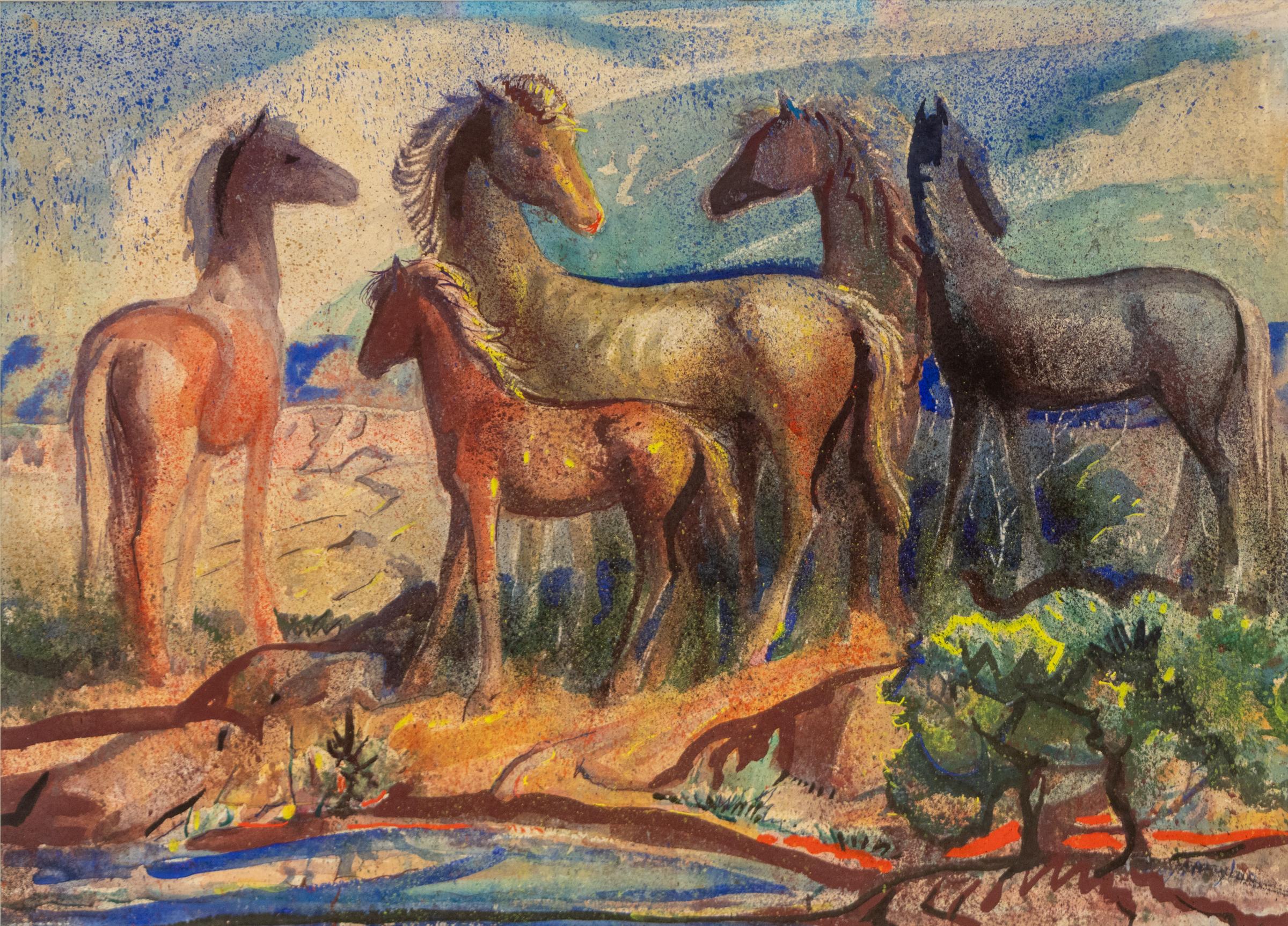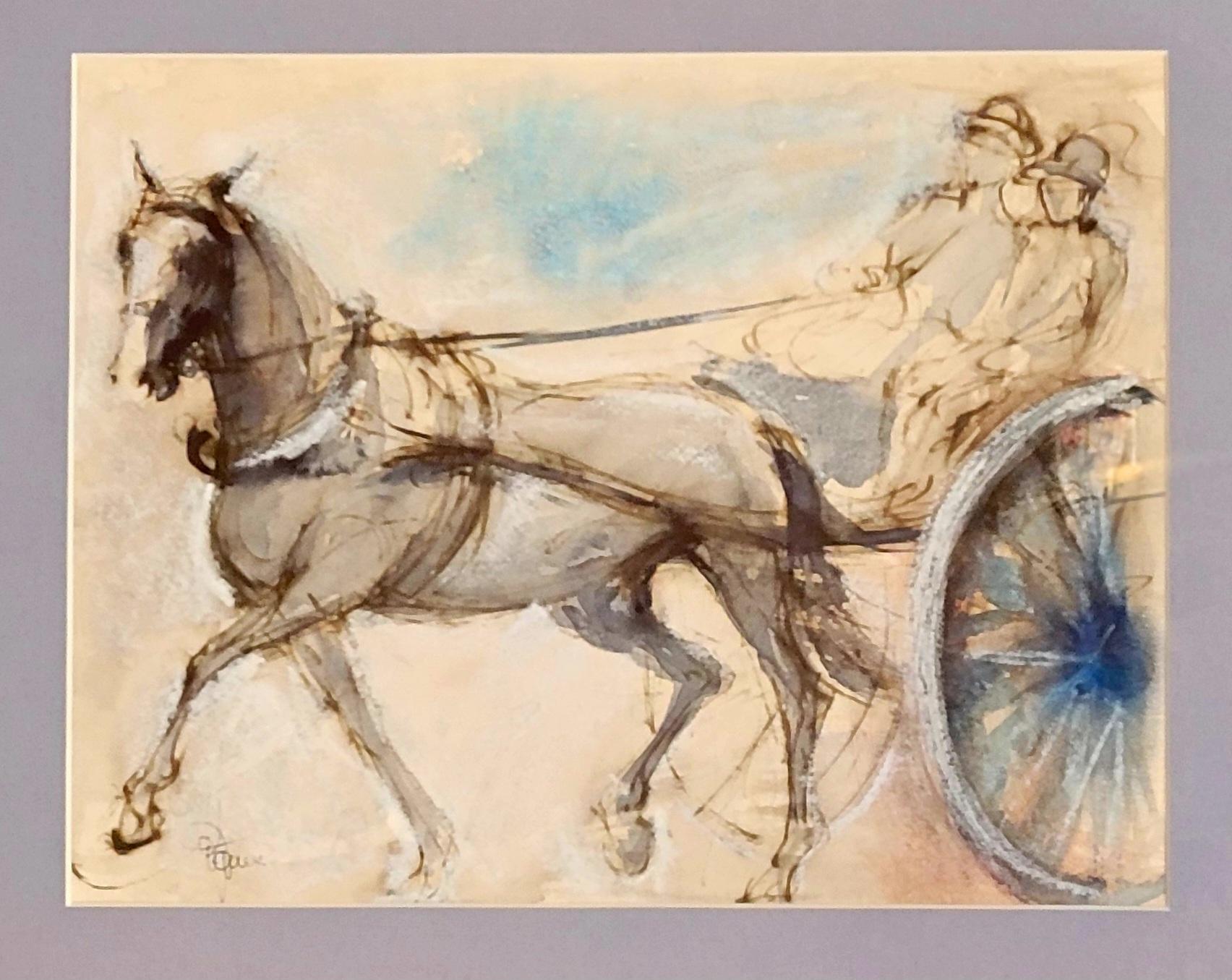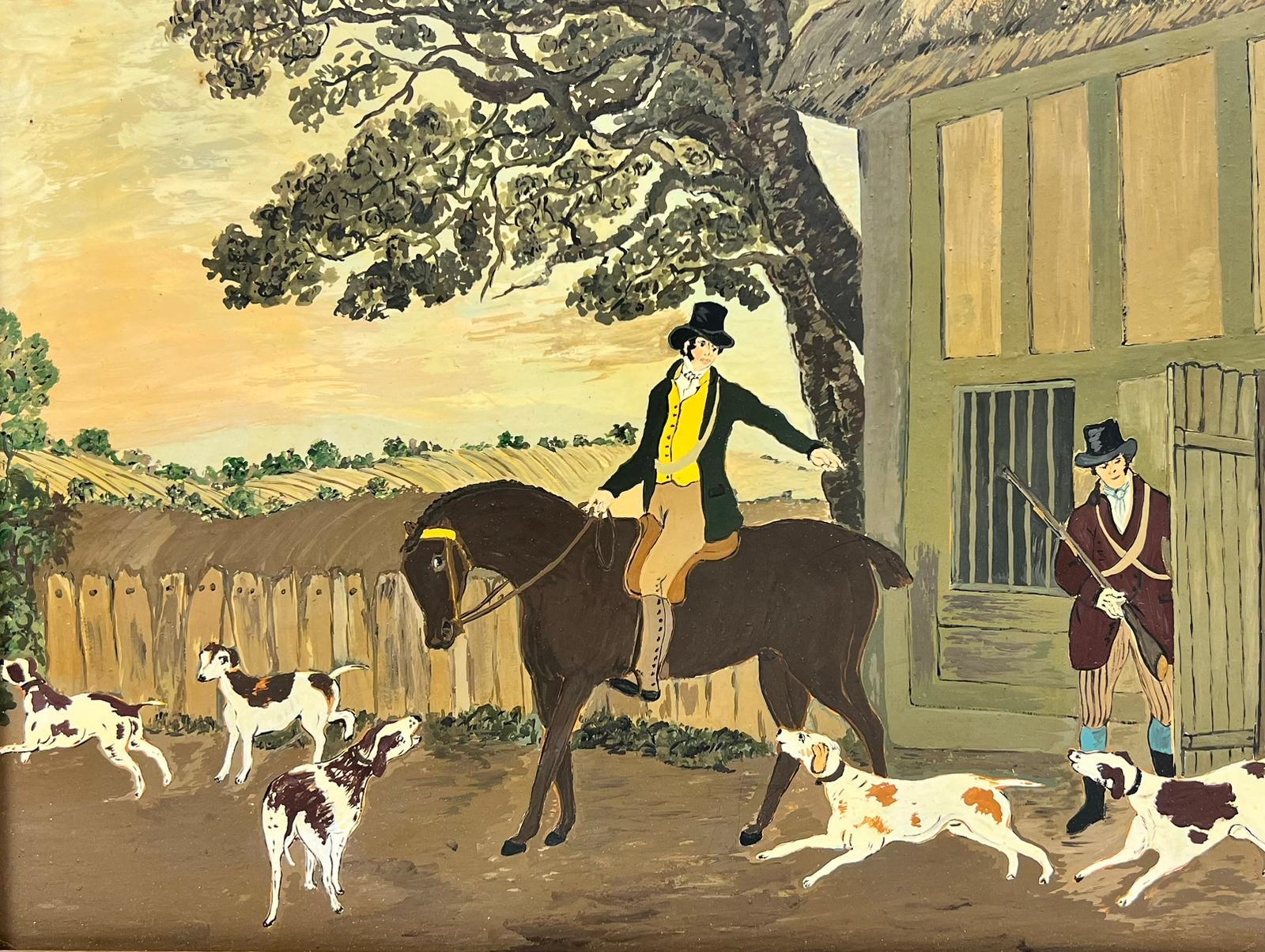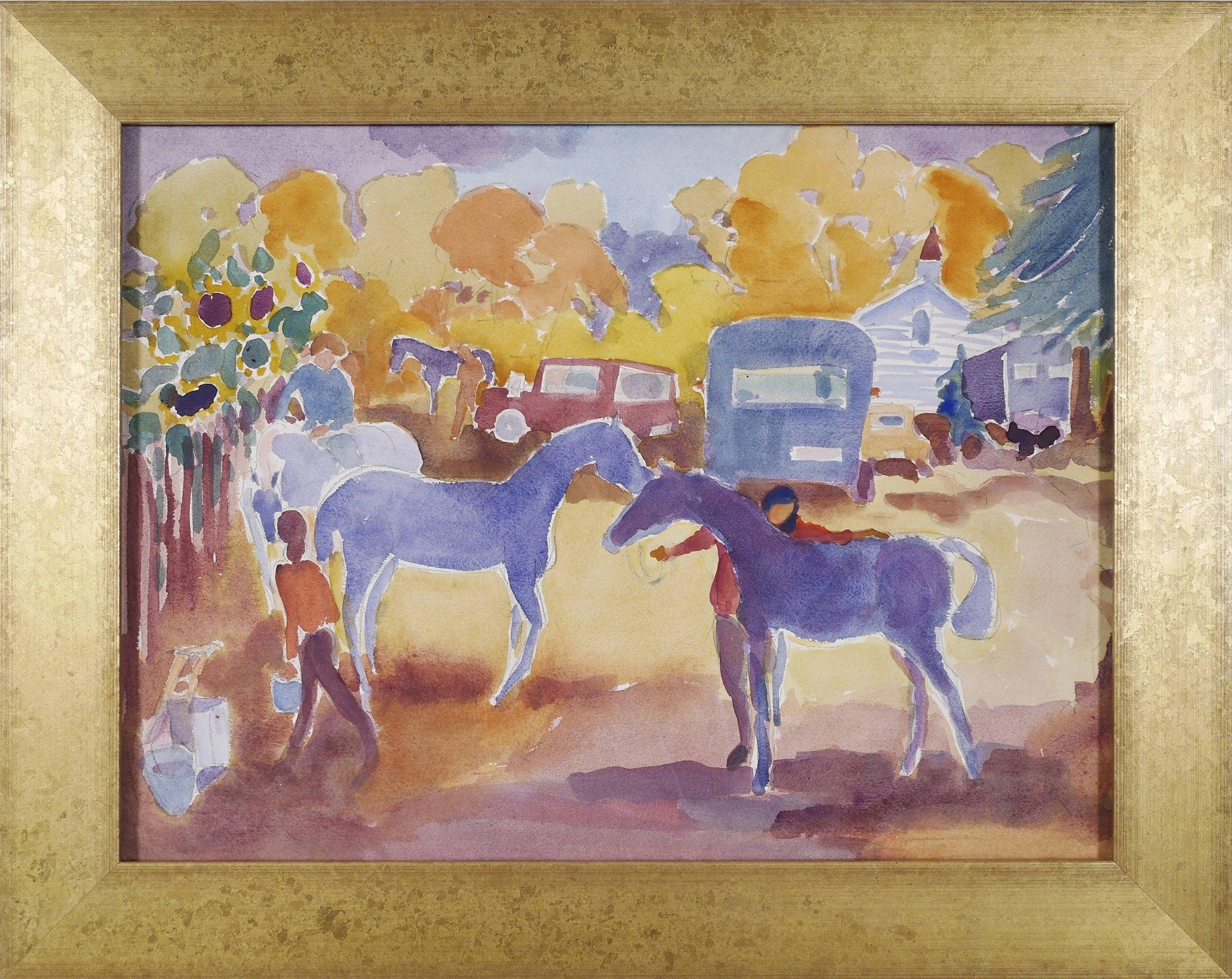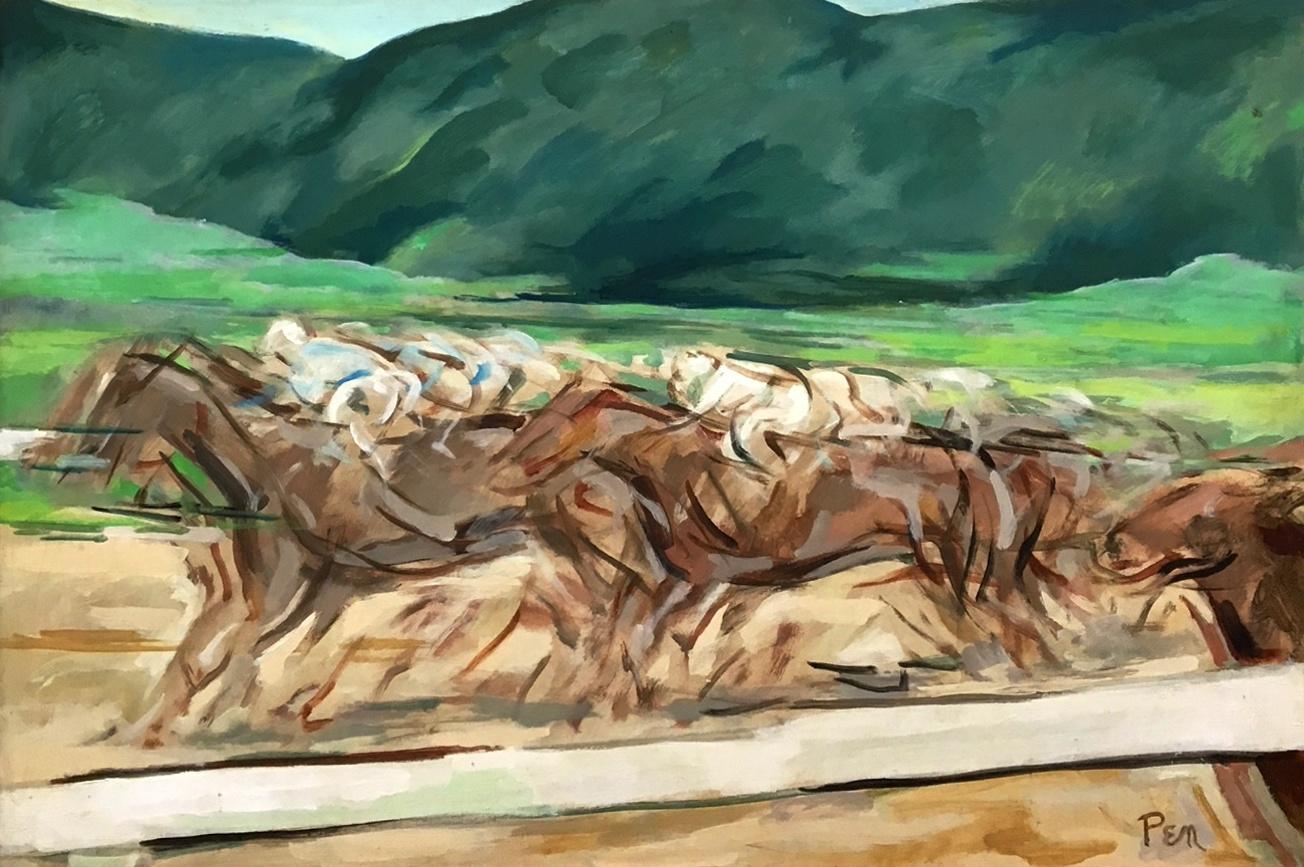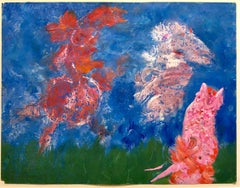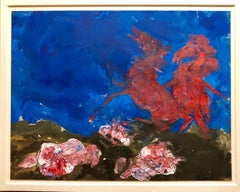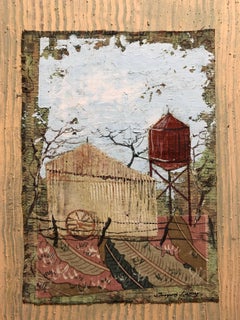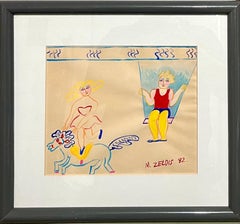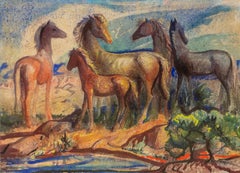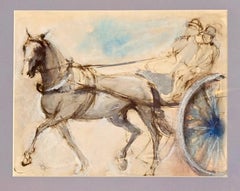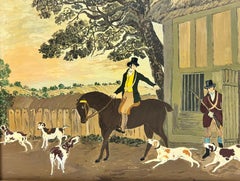Items Similar to 1948 American Folk Art Watercolor, Gouache, Painting Horse Farm, Running Horses
Want more images or videos?
Request additional images or videos from the seller
1 of 14
Cecilia "Peach" Taylor1948 American Folk Art Watercolor, Gouache, Painting Horse Farm, Running Horses1948
1948
$2,800
£2,114.30
€2,437.59
CA$3,951.99
A$4,356.31
CHF 2,279.43
MX$53,450.61
NOK 28,693.52
SEK 26,832.98
DKK 18,195.86
About the Item
Cecilia "Peach" Taylor (Mrs Reginald B. Taylor)
Folk Art watercolor painting of horses titled "White Horse Farm)
painted in 1948
A classic example of self taught, American Folk Art done in a naive style.
Framed 22.5 X 28.5, image 16 X 23
During the dismal years of the Great Depression until World War II, the East Aurora Hunt flourished in Western New York State, just southeast of Buffalo. According to a 1968 article that appeared in the East Aurora Shopping Guide, “The hunt was colorful, not only because of the scarlet coats but also the excitement it brought to the area each fall . . . It was a new source of village pride with everyone learning to share the exuberant interest of the huntsmen.”
In 1930, the country of the Lake Shore Hunt Club—a New York hunt that existed from 1920 to 1933—was divided and the East Aurora Hunt began. In the beginning, East Aurora shared MFHs—Howard Kellog and William C. Warren Jr.—with Lake Shore.
But by 1932, Mrs. Seymour H. (Helen) Knox and Mrs. Reginald B. (Cecelia “Peach”) Taylor took over as joint Masters of the East Aurora Hunt, and it is their legacy that reverberates in today’s equestrian community.
Knox’s granddaughter, Linda Knox McLean MFH, hunts the Aiken Hounds, and Taylor’s grandson was Mason Phelps Jr., the chairman of the National Horse Show Association and an alternate for the 1968 Olympic eventing team. Phelps started his eventing career riding his grandmother’s homebred field hunters, to the envy of other cross-country competitors.
The Masters of Foxhounds Association Executive Director Dennis Foster said that the National Steeplechase and Hunt Association, which still held records of hounds at that time, recognized the East Aurora Hunt on Jan. 1, 1932. Hunt colors were dark green with orange facings. There were two professional huntsmen officially listed, Frank Vinall (1932-34) and Fred Yull (1934-39).
Throughout East Aurora Hunt history, it was the Knox family that provided the club’s foundation. A mid-1930’s article from a Buffalo newspaper noted that “hunters gathered at the kennels on the Knox estate,” known then as Ess Kay Farm.
Seymour Horace Knox was the Buffalo, N.Y., businessman who made his fortune in five-and-dime stores when he merged his more than 100 stores with those of his first cousins, to form the F.W. Woolworth Company and then used his merger proceeds to purchase a controlling interest in the Marine Trust Co. (today HSBC Bank USA). His children, Seymour H. Knox II, Marjorie and Dorothy and their spouses were avid equestrians. Seymour II played polo along with his friend Reginald B. Taylor. And while they were both also foxhunters, it was their wives—Helen and Peach—who led the East Aurora Hunt.
- Creator:Cecilia "Peach" Taylor (American)
- Creation Year:1948
- Dimensions:Height: 22.5 in (57.15 cm)Width: 28.5 in (72.39 cm)
- Medium:
- Movement & Style:
- Period:
- Condition:good. minor wear to frame.
- Gallery Location:Surfside, FL
- Reference Number:1stDibs: LU38215875962
About the Seller
4.9
Platinum Seller
Premium sellers with a 4.7+ rating and 24-hour response times
Established in 1995
1stDibs seller since 2014
1,803 sales on 1stDibs
Typical response time: <1 hour
- ShippingRetrieving quote...Shipping from: Surfside, FL
- Return Policy
Authenticity Guarantee
In the unlikely event there’s an issue with an item’s authenticity, contact us within 1 year for a full refund. DetailsMoney-Back Guarantee
If your item is not as described, is damaged in transit, or does not arrive, contact us within 7 days for a full refund. Details24-Hour Cancellation
You have a 24-hour grace period in which to reconsider your purchase, with no questions asked.Vetted Professional Sellers
Our world-class sellers must adhere to strict standards for service and quality, maintaining the integrity of our listings.Price-Match Guarantee
If you find that a seller listed the same item for a lower price elsewhere, we’ll match it.Trusted Global Delivery
Our best-in-class carrier network provides specialized shipping options worldwide, including custom delivery.More From This Seller
View AllAmerican Neo Expressionist "Wild Horses" Modernist Oil Painting
By Robert Beauchamp
Located in Surfside, FL
Signed lower left.
Robert Beauchamp (1923 – March 1995) was an American figurative painter and arts educator. Beauchamp's paintings and drawings are known for depicting dramatic creatures and figures with expressionistic colors. His work was described in the New York Times as being "both frightening and amusing,". He was a Guggenheim Fellow and a student of Hans Hofmann.
Robert Beauchamp was born in Denver, Colorado in 1923. He had three brothers and three sisters, and the children were orphaned by both parents by the time Beauchamp was three. The family grew up impoverished due to the Great Depression, living in a community house with other families. As a child he dabbled in art but it wasn't until high school that he began taking art classes. When not creating art he also played sports; football and basketball, and enjoyed chemistry and geology.
He was told he was good at drawing, and replaced study hall classes with art classes, receiving instruction and inspiration from a Welsh teacher named R. Idris Thomas. While in high school Beauchamp would go, every Monday, to the public library and a local museum where he would read books about art; specifically French painting, as assigned by Thomas. Beauchamp absorbed the tenets of European Modernism and American Abstract Expressionism—with which he eventually broke. While abstraction, with its focus on color and form, underlies his compositions, he filled canvas and paper with psychologically acute portraits of himself and others, nudes, animals, and objects of all kinds. Beauchamp would spend upwards of four hours a day in the art room and eventually won the Carter Memorial Prize, which provided a scholarship to the Colorado Springs Fine Arts Center. At Colorado Springs he studied under Boardman Robinson, painting landscapes in nature.
Beauchamp eventually joined the Navy and then returned to Colorado Springs to continue his studies. Traveling the world as an Armed Guard, he spent a year and a half at sea and the rest of the three years in San Francisco. Seeking to make money, and to follow his love for a girl, Beauchamp decided to attend Cranbrook Academy of Art from 1947–1948. There he studied pottery, believing one could "make more money selling pots than you could selling paintings." He described his experience at Cranbrook as intimidating and claustrophobic, and eventually switched to sculpture before switching to painting.
Beauchamp moved to New York City in the early 1950s and was involved in the Tenth Street galleries, which provided outlets for more experimental artists and the second generation of abstract expressionists. Despite his involvement with 10th Street and friendships with abstract artists, abstract art never interested in him. He showed at numerous galleries in New York and Provincetown, socializing with gallery owners, artists and collectors. His first exhibition was at the Tanager Gallery in New York, he also showed during the 1950s at the Hansa Gallery. In New York and Provincetown he studied under Hans Hofmann Eventually he felt that abstract expressionism became dull and stalemated.
During the 1960s he showed at the Green Gallery. C. 1960 he was awarded a Fulbright Award allowing him to travel to La Romola, Italy. He traveled frequently to cities such as Rome and worked constantly. Beauchamp returned to the states and lived in Provincetown at Walter Gutman's house, who awarded Beauchamp a grant. That year he met his future wife, Nadine Valenti, whom he married in 1967. Beauchamp taught at a variety of schools during his lifetime including Brooklyn College, School of Visual Arts, Cooper Union and the Art Students League of New York during the last fifteen years of his life.
Beauchamp described his drawings as painterly, seeking the spontaneity in an image. He would develop a drawing then a painting, and vice versa. His heavily impastoed paintings, often described as sculptures themselves, came from the pouring of paint from a can, with little planning and constant evolution in the medium upon the canvas. He preferred little planning to his creations, believing that an artists work would become stale and repetitive with constant planning.
He also created large scale works, at times 70 inches long. Beauchamp had little intention of ever selling his large works, preferring to create them due to the slow and intense experience he received from the process. The large drawings he created on the floor, and the smaller works were created on a table. Paintings were created on either the floor or wall and he described his painting process as "splattering", "pushing the paint around," and sponging.
Animals often appear in his paintings, despite a dislike for domestic animals outside of his artistic creations. He called the characters in his paintings as Beauchamps. Some Beauchamps hold meaning, with Beauchamp rarely sharing the meaning behind the symbols and characters. He made up the creatures himself, seeking to emphasize the character of each.
In 2006 the University of Massachusetts Amherst College of Visual & Performing Arts hosted an exhibition of Beauchamp's pieces from the 1960s, curators stated that Beauchamp's work: "effortlessly blends innovative style elements with narrative, descriptive images. One senses equal enjoyment in the manipulation of, and interaction with, color and paint, and the often sudden and unexpected presence of a wasp or a lump of sugar."
included in the important exhibit "Twelve New York Painters." New York: David Findlay Jr. Fine Art with Mary Abbott, Alcopley, Robert Beauchamp, Byron Browne, Charles Cajori, Jim Forsberg, Carl Heidenreich, Angelo Ippolito, Emily Mason, Robert Natkin, Robert Richenburg and Nina Tryggvadottir...
Category
20th Century Neo-Expressionist Abstract Paintings
Materials
Paper, Oil
American Neo Expressionist "Wild Horses" Modernist Oil Painting
By Robert Beauchamp
Located in Surfside, FL
Robert Beauchamp (1923 – March 1995) was an American figurative painter and arts educator. Beauchamp's paintings and drawings are known for depicting dramatic creatures and figures with expressionistic colors. His work was described in the New York Times as being "both frightening and amusing,". He was a Guggenheim Fellow and a student of Hans Hofmann.
Robert Beauchamp was born in Denver, Colorado in 1923. He had three brothers and three sisters, and the children were orphaned by both parents by the time Beauchamp was three. The family grew up impoverished due to the Great Depression, living in a community house with other families. As a child he dabbled in art but it wasn't until high school that he began taking art classes. When not creating art he also played sports; football and basketball, and enjoyed chemistry and geology.
He was told he was good at drawing, and replaced study hall classes with art classes, receiving instruction and inspiration from a Welsh teacher named R. Idris Thomas. While in high school Beauchamp would go, every Monday, to the public library and a local museum where he would read books about art; specifically French painting, as assigned by Thomas. Beauchamp absorbed the tenets of European Modernism and American Abstract Expressionism—with which he eventually broke. While abstraction, with its focus on color and form, underlies his compositions, he filled canvas and paper with psychologically acute portraits of himself and others, nudes, animals, and objects of all kinds. Beauchamp would spend upwards of four hours a day in the art room and eventually won the Carter Memorial Prize, which provided a scholarship to the Colorado Springs Fine Arts Center. At Colorado Springs he studied under Boardman Robinson, painting landscapes in nature.
Beauchamp eventually joined the Navy and then returned to Colorado Springs to continue his studies. Traveling the world as an Armed Guard, he spent a year and a half at sea and the rest of the three years in San Francisco. Seeking to make money, and to follow his love for a girl, Beauchamp decided to attend Cranbrook Academy of Art from 1947–1948. There he studied pottery, believing one could "make more money selling pots than you could selling paintings." He described his experience at Cranbrook as intimidating and claustrophobic, and eventually switched to sculpture before switching to painting.
Beauchamp moved to New York City in the early 1950s and was involved in the Tenth Street galleries, which provided outlets for more experimental artists and the second generation of abstract expressionists. Despite his involvement with 10th Street and friendships with abstract artists, abstract art never interested in him. He showed at numerous galleries in New York and Provincetown, socializing with gallery owners, artists and collectors. His first exhibition was at the Tanager Gallery in New York, he also showed during the 1950s at the Hansa Gallery. In New York and Provincetown he studied under Hans Hofmann Eventually he felt that abstract expressionism became dull and stalemated.
During the 1960s he showed at the Green Gallery. C. 1960 he was awarded a Fulbright Award allowing him to travel to La Romola, Italy. He traveled frequently to cities such as Rome and worked constantly. Beauchamp returned to the states and lived in Provincetown at Walter Gutman's house, who awarded Beauchamp a grant. That year he met his future wife, Nadine Valenti, whom he married in 1967. Beauchamp taught at a variety of schools during his lifetime including Brooklyn College, School of Visual Arts, Cooper Union and the Art Students League of New York during the last fifteen years of his life.
Beauchamp described his drawings as painterly, seeking the spontaneity in an image. He would develop a drawing then a painting, and vice versa. His heavily impastoed paintings, often described as sculptures themselves, came from the pouring of paint from a can, with little planning and constant evolution in the medium upon the canvas. He preferred little planning to his creations, believing that an artists work would become stale and repetitive with constant planning.
He also created large scale works, at times 70 inches long. Beauchamp had little intention of ever selling his large works, preferring to create them due to the slow and intense experience he received from the process. The large drawings he created on the floor, and the smaller works were created on a table. Paintings were created on either the floor or wall and he described his painting process as "splattering", "pushing the paint around," and sponging.
Animals often appear in his paintings, despite a dislike for domestic animals outside of his artistic creations. He called the characters in his paintings as Beauchamps. Some Beauchamps hold meaning, with Beauchamp rarely sharing the meaning behind the symbols and characters. He made up the creatures himself, seeking to emphasize the character of each.
In 2006 the University of Massachusetts Amherst College of Visual & Performing Arts hosted an exhibition of Beauchamp's pieces from the 1960s, curators stated that Beauchamp's work: "effortlessly blends innovative style elements with narrative, descriptive images. One senses equal enjoyment in the manipulation of, and interaction with, color and paint, and the often sudden and unexpected presence of a wasp or a lump of sugar."
included in the important exhibit "Twelve New York Painters." New York: David Findlay Jr. Fine Art with Mary Abbott, Alcopley, Robert Beauchamp, Byron Browne, Charles Cajori, Jim Forsberg, Carl Heidenreich, Angelo Ippolito, Emily Mason, Robert Natkin, Robert Richenburg and Nina Tryggvadottir...
Category
20th Century Neo-Expressionist Abstract Paintings
Materials
Paper, Oil
Mixed Media Farmhouse, Barn Oil Painting Collage
By Jacques Lamy
Located in Surfside, FL
A contemporary mixed media painting on cloth, plaster and board created by listed Texas artist Jacques Lamy (French/American, 1946 – 2016). The piece uses a combination of woven and printed cloth, plaster, burlap, textured board and paint to depict a rural farm landscape under blue skies. The work is signed by hand to the lower right.
Born in Paris in 1946 and raised in the heart of an idyllic French countryside near the Loire Valley, Jacques Lamy began painting at a very early age. Jacques completed his formal artistic training at the prestigious Ecole Nationale Superieur des Arts Decoratifs (Paris) in 1971. While there, he received the highest peer recognition in European Arts; the coveted Prix de Rome award for painting.
Jacques Lamy’s career as an artist, designer and art teacher took him from his native France to life abroad in Spain, Africa, and the United States. His broad artistic interests and his classic training in art and design have enabled him to enjoy a wide variety of artistic experiences from designing furniture, lamps, tapestries, and elegant garden statuary to creating large scale murals for public viewing and enjoyment.
in addition to his renowned mural work, Jacques received international recognition for his decorative fresco paintings.
Jacques personal artistic style is very much a melding of old and new – a merging of a classically trained artist with a modern artistic vision. The medium is multi-media and the composition has a modern, abstract quality but the Old World training in design and composition lends the whole an air of classical grace. Examples can be seen in his studio-gallery in Dallas, Texas.
Art Education Ecole National Superieure des Arts Decoratifs – Paris
Art Teaching Casa de Velasquez – Madrid, Spain.
National Institute of Art, Dakar, Senegal.
Has taught art in France, Spain, and Africa
Art Awards Prix de Rome de Peinture – Casa de Velasquez - 1971
Silver Medal for Industrial Creation - 1981
Museums Musee D'Art Roger Quillot, Clermont-Ferrand, France
Jesuit Art Museum – Dallas, TX
Exhibits
2012-current Represented by Wall Gallery – Dallas, TX, USA
2004 Jesuit Art Museum – Dallas, TX, USA
2001-current Galerie Fine Art – Nantes, France
2000 City Hall, Chamalieres – France
1998 Ivanffy – Uhler Gallery – Dallas, TX
1994-1996 Jacques Lamy Fine Art Gallery
1995 Neiman Marcus- Dallas and Atlanta
1981-1984 Gallery Frederic Mechiche...
Category
20th Century Contemporary Mixed Media
Materials
Fabric, Paint, Mixed Media
Malcah Zeldis Folk Art Gouache Painting Outsider Circus Trapeze Horse Acrobats
Located in Surfside, FL
MALCAH ZELDIS
Circus, Trapeze Artists, Horse rider and Acrobats
gouache on paper
Hand signed and dated bottom right. titled in pencil on paper verso.
Fr...
Category
1980s Folk Art Figurative Paintings
Materials
Paper, Gouache
1940's Americana WPA Modernist Watercolor Painting Catskill Mountains Bungalow
By Samuel Grunvald
Located in Surfside, FL
Bungalow (fauvist painting of New York scene) 1940's.
image is 10X 11.5 inches. Hand signed lower right
Country Scene
Samuel Grunvald was a Hungarian born American WPA artist known for abstract, landscape and seascape paintings.
Arrived in the USA from Hungary in 1921 and settled in New York City where he studied at the Art Students League. Grunvald worked for the Federal Art Project, taught at Colony House in NYC. Member: Art Guild, Watercolor Society, New York Watercolor Club. exhibited at Montross Gallery, NYC, World House Galleries, NYC, Leonard Hutton Gallery, NYC, Associated American Artists Gallery and the A.C.A. Gallery. Gunvald's work spanned many modern American movements from the WPA to Abstract Expressionist painting. He was a member of the American Watercolor Society and the Brooklyn Society of Artists. He exhibited with both of these organizations and at the Brooklyn Museum of Art. He was involved the the WPA being a Federal Arts Project artist. A number of prominent Jewish artists participated in this New Deal program among them Ben Shahn, Joseph Solman, William Gropper, Philip Guston Adolph Gottlieb, Mark Rothko, Milton Avery, Ben Shahn, the Soyers (Isaac, Moses, and Raphael), and many others
Grunwald exhibited alongside other popular artists such as Paul Klee, Jean Arp, Max Ernst and Charles Burchfield. He also taught and lectured on art and easel painting, Federal Art Project, NYC. His work is included in the collections of the Museum of Modern Art and The Jewish Museum, New York. Americana.
The Catskills became a major resort destination for Jewish New Yorkers in the mid-20th century. Borscht Belt is an informal term for the summer resorts of the Catskill Mountains in Sullivan and Ulster counties in upstate New York which were frequented by Ashkenazi Jews. At its peak of popularity, about 500 resorts operated in the region. Later changes in vacationing patterns have led most of those travelers elsewhere, although there are still bungalow communities and summer camps in the towns of Liberty, Bethel, Monticello and Fallsburg catering to Orthodox Jewish populations. Borscht Belt, The term, which derives from the name of a beet soup popular with people of Eastern European origin, can also refer to the Catskill region itself.
In August, 1969, the Catskills were the site of a music and art festival in the town of Bethel, which had originally been planned for Woodstock, New York. Thirty-three of the best-known musicians of the era appeared during a sometimes rainy weekend in front of nearly half a million concertgoers. The event, featuring liberal drug use and nudity, exemplified the counterculture of the 1960s and 1970s.
Select Exhibitions
A.C.A. Gallery
Associated American Artists Gallery, 1936-1955
American Watercolor Society, 1932-1942
New York Watercolor Club, 1935-1937
Humanist Art...
Category
1940s Modern Figurative Drawings and Watercolors
Materials
Watercolor
Large Jack Balas Contemporary Modernist Horse Enamel & Oil Painting Western Art
By Jack Balas
Located in Surfside, FL
Jack Balas
Grid Study, Appaloosa
Oil and Enamel on Board
Inscribed verso, dated 1997-99 and hand signed l.l.
Sight: 24 x 48 in. (61 x 121.9 cm.), Frame: 26 x 50 x 2 in. (65.4 x 127 ...
Category
1990s American Realist Animal Paintings
Materials
Enamel
You May Also Like
1930s WPA Era Watercolor Painting of Horses in a Southwest Landscape
By Lloyd Moylan
Located in Denver, CO
Immerse yourself in the beauty of the American Southwest with this stunning vintage painting by renowned artist Lloyd Moylan (1893–1963). This masterful watercolor and gouache on pap...
Category
1930s American Modern Animal Drawings and Watercolors
Materials
Watercolor, Gouache
Horse and Trap. Gouache and Watercolor.
Located in Cotignac, FR
Early 20th century watercolour and gouache of a horse and trap. Signed to the bottom left but artist unknown.
This dynamic artwork showcases a striking horse pulling a two-wheeled c...
Category
Early 20th Century Outsider Art Drawings and Watercolor Paintings
Materials
Ink, Watercolor, Gouache, Paper
"Tom's Day" c1961 Equestrian Watercolor
Located in Bristol, CT
Art Sz: 11 3/4" x 15 3/4"W
Frame Sz: 17 7/8"H x 22"W'
w/ yellow mat & gilt bamboo frame
Category
Mid-20th Century Drawings and Watercolor Paintings
Materials
Watercolor
Folk Art Naive English Oil Painting Country Gentleman on Horseback with Hounds
Located in Cirencester, Gloucestershire
English Naive/ Folk Art School, 20th century
oil on board, framed
framed: 12 x 16 inches
board: 11.5 x 14 inches
provenance: private collection, England
condition: overall very good
Category
20th Century Folk Art Landscape Paintings
Materials
Oil
Horse Show Preparations, 20th Century Farm Landscape, Cleveland Female Artist
Located in Beachwood, OH
Algesa O'Sickey (American, 1917-2006)
Horse Show Preparations
Watercolor and graphite on paper
Unsigned
18 x 24 inches
23.25 x 29 inches, framed
Born Algesa D’Agostino on June 4, 1...
Category
20th Century Animal Drawings and Watercolors
Materials
Graphite, Watercolor
A Dynamic Mid-Century Modern Horse Race Painting by Chicago Artist, Rudolph Pen
Located in Chicago, IL
A Large, Dynamic Mid-Century Modern Painting of a Horse Race by noted Chicago Artist, Rudolph Pen. Artwork size: 24" x 36"; Framed size: 25" x 37". Signed "Pen" lower right and ti...
Category
Mid-20th Century American Modern Animal Paintings
Materials
Masonite, Oil
